Whitetip Reef Shark
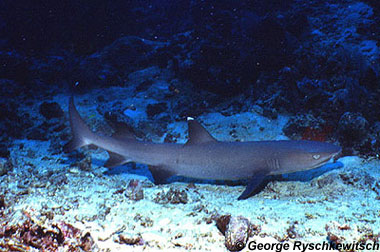
Triaenodon obesus
The Whitetip Reef Shark is a smaller, greyish brown shark with a distinctive white tip on its dorsal and caudal fins. (Compagno, 2005) It prefers caves and coral reefs, often be found resting by the bottom of the ocean by day and hunting by night (Compagno, 2005). Unlike many sharks, it does not need to constantly swim in order to breathe. (Compagno, 1984)This is one of the few requiem sharks that doesn’t have to keep swimming to breathe. This shark rarely shows aggression towards humans (Compagno, 2005).
Order – Carcharhiniformes
Family – Carcharhinidae
Genus – Triaenodon
Species – obesus
Common Names
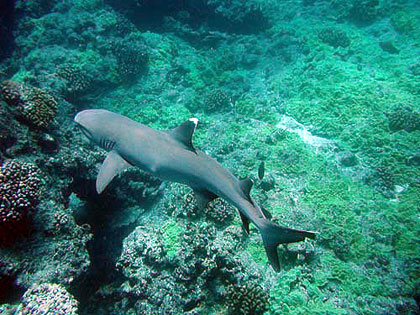
- English: whitetip reef shark, blunthead shark, light-tip shark, reef whitetip, whitetip shark
- Afrikaans: stompkophaai
- Arabic: gursh
- Carolinian: mweshar, peu
- Dutch: witpuntrifhaai
- Finnish: valkoevähai
- French: aileron blanc de lagon, endormi requin, requin à pointes blanches, requin corail
- Gela: eno-eno
- German: riffhai, weißspitzenhundshai
- Hawaiian: manô lâlâ kea
- Japanese: nemuribuka
- Kirabati: te bakoa
- Maldivian: faana miyaru, miyaru
- Malay: ikan yu
- Marshallese: pako korak
- Niuean: maog
- Portuguese: marracho de covas
- Samoan: malu,
- Somali: daaha, libaax
- Spanish: cazón, cazón coralero trompacorta, tintorera punta aleta blanca
- Swahili: papa, papa sarawanzi
- Tagalog: pating
- Tahitian: mamaru
- Tuamotuan: arava
- Tuvaluan: te alabafrnua
Importance to Humans
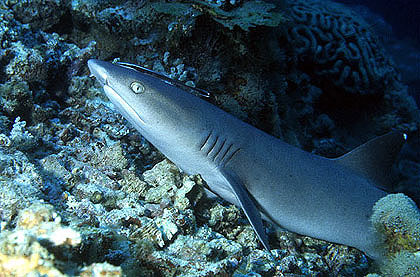
Ongoing fishing and the harvesting of biological resources continues to threaten this shark. (Smale, 2009) It has been reported by tropical fisheries multi-species shark catch reports that the whitetip reef shark is often taken inline or from shallow water net trawls. It is most threatened in heavily fished tropical areas. (Smale, 2009) In some markets, the meat and liver are eaten and sold for human consumption. However, there is a risk of ciguatera poisoning, a type of food poisoning present in reef fish (Randall, 1977). Currently, it is becoming a source of ecotourism in many countries. (Compagno, 2005)
Danger to Humans
This shark rarely shows aggression (Compagno, 2005). The shark has a naturally placid nature to where they can be hand-fed (Fitzpatrick, 2011). After continual exposure to ecotourism, many of the sharks, although nocturnal, will swim to the surface during the day at the sound of the boat engine in anticipation of food. (Fitzpatrick, 2011) The known attacks are unprovoked and non-fatal (Florida Museum, 2018). It is never advisable to feed wildlife.
In Hawaii, some families regarded this shark as ‘aumakua’, a guardian spirit. They would feed rather than hunt whitetip reef sharks.
Conservation
This shark is currently listed by the World Conservation Union (IUCN) as “Near Threatened” at this time. With widespread expansion of the fishing industry over the past 20 years, the preferred habitat (coral reefs) and abundance of the shark has decreased while fishing pressure has increased significantly (Smale, 2009). The small litter size and late maturity age indicate a slower rebound from a population decrease and may lead to the species becoming threatened soon. (Smale, 2009) Although no conservation efforts are currently in place, it is believed that the site fidelity and locality of this species could open up the possibility of Marine Reserves to serve as protected areas for the populations. (Smale, 2009)
> Check the status of the whitetip reef shark at the IUCN website.
The IUCN is a global union of states, governmental agencies, and non-governmental organizations in a partnership that assesses the conservation status of species.
Geographical Distribution
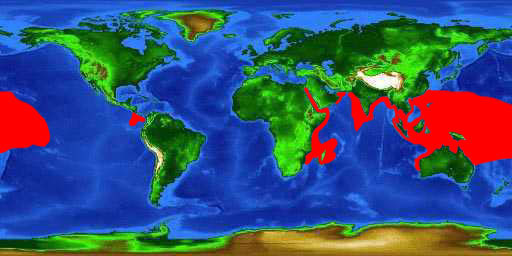
It resides in the Indo-Pacific (Compagno, 2005). Its range includes South Africa, the Red Sea to Pakistan, Sri Lanka, Burma, Indonesia, Vietnam, Taiwan, Riu Kiu Islands, Philippines, Australia and New Guinea (Smale, 2009). It is common in Polynesia, Melanesia, and Micronesia, northward to the Hawaiian Islands, and southwest to the Pitcairns. In the eastern Pacific, the shark resides in waters off the Cocos and Galapagos Islands, and from Panama and north to Costa Rica. (Smale, 2009)
Habitat
This species typically lives along the bottom in clear, shallow waters surrounding coral reefs at depths of 26.25- 131.23 feet (8-40 m) but has been spotted at depths reaching 1,083 feet (330 m). (Compagno, 2005) Typically a nocturnal shark, this species lives in caves during the day and becomes active at night. (Smale, 2009) Even though it covers a wide geographical range, the sharks exhibit site fidelity by returning to the same caves and coral reefs. (Whitney, 2012) Whitetip reef sharks can occupy the same home for a range of months to years without conflict with the sharks around them (Compagno, 2005). They are typically social sharks with a communal, non-territorial lifestyle. (Compagno, 2005)
Biology
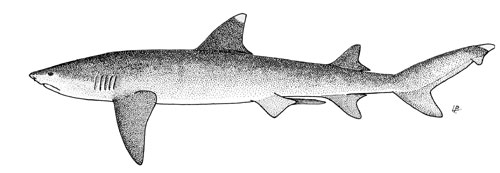
Distinctive Features
This slender, small shark possesses a broad, flattened head with a rounded snout and horizontally oval eyes (Compagno, 2005) One of the most distinctive features is the bright white coloration of the tips of the first dorsal and upper caudal fins. (Compagno, 2005) The large first dorsal fin originates well behind the free rear tips of the broad and triangular pectoral fins. While the anal fin and second dorsal fin are nearly equal in size, the shark lacks an interdorsal ridge. (Compagno, 2005)
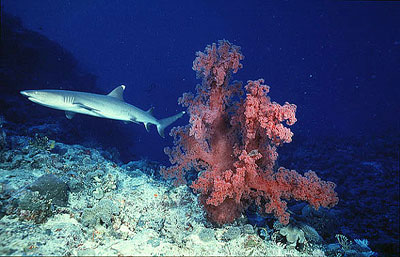
Coloration
The common name comes from the distinct white tips on the first dorsal and upper caudal fins (Compagno, 2005). The greyish-brown body tends to fade to a lighter color as it reaches the underside; its sides are dotted with small dark spots. (Compagno, 2005)
There may arise some confusion between the whitetip reef shark and the silvertip shark (C. albimarginatus). The silvertip shark is a much heavier species with a large first dorsal and a much smaller second dorsal fin. (Compagno, 2005) Also, its caudal fin is lined with a faded white rather than tipped as in the whitetip reef shark. (Compagno, 2005)
Dentition
In each jaw, there are about 43-50 teeth with at least two functioning rows. The tricuspid teeth have one to two small cusps on each side of the larger, central cusp in the middle. (Randall, 1977)
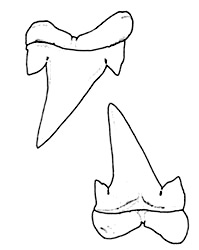
Size, Age, and Growth
This shark can grow to a maximum length of just under 7 feet (213 cm), but adults rarely reach over 6 feet. (Randall, 1977) Males mature at about 3.4 feet (1.05 m) and generally reach 5.5 feet (1.68 m) in length (Randall, 1977; Compagno, 2005). Females reach maturity at 3.4-3.57 feet (1.05-1.09 m) and grow to at least 5.18 feet (1.58 m). (Randall, 1977; Compagno, 2005) This species is known to reach a maximum age of about 25 years (Compagno, 2005)
Food Habits
This nocturnal species feeds at night on cave and bottom-dwelling prey as well as reef organisms. This includes a range of mollusks, crustaceans, and a variety of teleost. (Whitney, 2012) The whitetip reef sharks adaptation for reef feeding makes them adept at reaching crevices and cracks in the coral reefs for fish, allowing it to prey on animals that other species of shark cannot reach. (Randall, 1977)
Reproduction
During mating, the male whitetip reef shark lies next to the female, using his mouth to hold on to her pectoral fins. This is followed by the male inserting one of his claspers into her genital opening, releasing sperm. This species is viviparous, meaning embryos are nourished via a placenta-like attachment to the mother during gestation and have litters of about 1-5 pups. (Compagno, 2005) A study found of Whitetip reef shark reproduction, a gestation period of 11-12 months was examined in the Great Barrier Reef in Australia, determining that in that part of the world this species gives birth in October (Whitney, 2012). The biggest portion of pregnant females in this species are observed in June and July, suggesting that pupping takes place around May. (Whitney, 2012) The gestation period is typically 5 months and maturation may take up to five years. (Compagno, 2005) This species is relatively slow-growing for sharks with an average annual growth of about 2.1-4.2 cm and the average size at birth being 52-60 cm. (Smale, 2009)
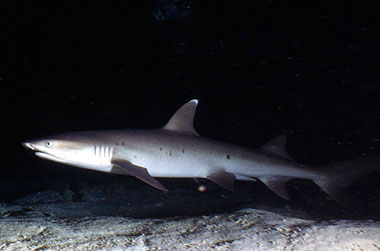
Predators
The stomach contents of giant grouper (Epinephelus lanceolatus) have been found to contain this species of shark. The Tiger shark (Galeocerdo cuvier) is a more common predator. Whitetip reef sharks have been used as bait for tiger sharks in the past. (Randall, 1977)
Parasites
The copepod Paralebion elongatus is a parasite reported from whitetip reef sharks caught in Hawaiian waters.
Taxonomy
Rüppell originally described this shark as Carcharias obesus in 1837. This name was changed to the currently valid scientific name of Triaenodon obesus (Rüppell, 1837) later that same year. A synonym referring to this species that has appeared in previous scientific literature is Triaenodon apicalis (Whitely 1939).
Prepared by: Cathleen Bester
Revised by: Tyler Bowling and Cara Trench 2019
References:
- Compagno, Leonard. A Field Guide to the Sharks of the World. Lnodon, Harper Collins Publishers, 2005.
- Compagno, Leonard. Sharks of the World: An Annotated and Illustrated Catalogue of Shark Species Known to Date. Hexanchiformes to Lamniformes, Issues 3-4; Issue 125. United Nations Development Programme, 1984.
- Fitzpatrick, R., Abrantes, K.G., Seymour, J. et al. Coral Reefs (2011) 30: 569. https://doi.org/10.1007/s00338-011-0769-8
- Randall, John E. “Contribution to the Biology of the Whitetip Reef Shark (Triaenodon obesus)” Pacific Science (1977), vol. 31, no. 2 © 1977 by The University Press of Hawaii. pp. 143-161.
- Sazima, Ivan. Moura, Rodrigo L. “Shark (Carcharhinus perezi), Cleaned by the Goby (Elacatinus randalli), at Fernando de Noronha Archipelago, Western South Atlantic”. Copeia, Vol. 2000, No. 1 (Feb. 1, 2000), pp. 297-299
- Smale, M.J. 2009. Triaenodon obesus. The IUCN Red List of Threatened Species 2009: e.T39384A10188990. http://dx.doi.org/10.2305/IUCN.UK.2005.RLTS.T39384A10188990.en. Downloaded on 13 February 2019.
- Whitney, N.M., Pyle, R.L., Holland, K.N. et al. Environ Biol Fish (2012) 93: 121. https://doi.org/10.1007/s10641-011-9897-9